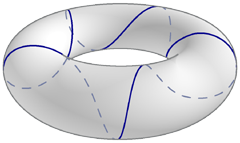This is the list of projects for 2019.

Closed geodesic on flat spaces
In Euclidean space, the shortest path between two points is a straight line. In non-Euclidean spaces, geodesics abstract the notion of a straight line. For example, on the sphere the shortest paths are the great circle geodesics, and we fly “over the pole” when traveling from NYC to Paris. Last summer students studied closed geodesics on doubled polygons, where geodesics billiard off the edges. This summer, we’ll consider closed geodesics on flat surfaces, generalizations of doubled polygons which locally exhibit Euclidean geometry while globally having properties of negative curvature.
Mentor: Ian Adelstein and Aaron Calderon
Primitive sets of polynomials
A set of integers is primitive if no number in the set divides another. For example, the prime numbers form a primitive set, however there are many other examples. There are even primitive sets which are `”larger” than the primes. In this project we will look at primitive sets of polynomials with coefficients from a finite field. This ring of polynomials over a finite field behaves in many ways like the integers, but the techniques for studying problems over this ring are often more combinatorial than over the integers. We will investigate what the “largest” primitive sets are in this setting, as well as counting how many primitive sets there are. A convenient way to model the situation is using divisibility graphs, and so related questions involving independent vertex sets of graphs may be considered as well.
Mentor: Nathan McNew
Multiscale Analysis on Graphs
Kernel-based techniques are a set of Harmonic Analysis tools for graphs and manifolds that address critical challenges in the analysis and storage of large datasets. Diffusion Maps, introduced by Coifman and Lafon, is a multiscale, non-linear algorithm in this family. This technique unveils the underlying manifold, usually a lower-dimensional in which the data is embedded, using the eigenvalues and eigenvectors of the diffusion operator on the data. Diffusion Maps have gained popularity in many applications that require dimensionality reduction and feature extraction. This project is two-folds: first, we use Diffusion Maps in conjunction with other machine learning tools, e.g., neural nets, to analyze medical data, and second, we look at Diffusion Maps in the broader context of Harmonic Analysis and establish links between diffusion methods and composite dilation methods on Euclidean spaces. Some coding experience is recommended but not required.
Mentor: Karamatou Yacoubou Djima
Geometry Group (Isoperimetric Problems)
In Euclidean space (and in hyperbolic space) the round sphere provides the least-area way to enclose given volume—solves the isoperimetric problem. What happens if you give space a density that weights both area and volume? In the Euclidean plane the regular hexagonal provides the least-perimeter tile of fixed area. What happens in the hyperbolic plane? For some earlier results and references, see “Geometry Group 2019” at https://sites.williams.edu/Morgan/ and also here.
July 13-27 we’ll go on a retreat to Ocean City, New Jersey, living and working together free from the usual distractions; the four of you will be provided with two bedrooms to share (each with two beds, or other options). In the past, this retreat has been crucial to making headway in parts that require a great deal of focused attention.
Mentor: Frank Morgan
Intersections of virtual multistrings
In this project, we will explore the interplay between the combinatorial and geometric models of closed curves on surfaces. Turaev, Henrich, and Cahn used the combinatorial model to develop a based matrix associated to a single closed curve, an object that captures various geometric properties of the curve. More recently, this notion was extended to multiple curves, but it is unknown how much geometric data is captured by this generalized based matrix. Of particular interest is the minimal number of intersection points between two curves. Based matrices and other operations provide lower bounds on this quantity and we want to develop a better classification of the strengths of each of these techniques. All of these questions should be accessible to undergraduates and can be tailored to their backgrounds.
Mentor: David Freund